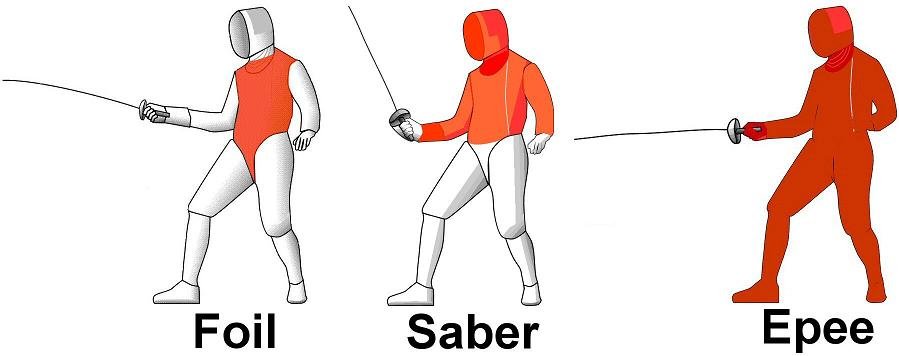Target Areas by Weapon Class
Fencing Rules by Weapon Class
In fencing, matches are timed and divided into 3 bouts, with each match lasting 3 minutes, or until a fencer reaches 15 points. Matches are overseen by a referee, who in conjunction with an electric scoring machine, deduces which fencer is awarded a point according to the specific sword-class bout rules.
Epee
In epee, the target is the entire body, including the toes and the head. An epee attack is done with the point of the weapon, and the point is awarded to the fencer that lands a hit first, and is signaled by the electric scoring machine. With epee, there are no ‘right of way’ rules regarding attacks, and thus, double-hits are allowed in epee; however the hits must occur within 40 milliseconds of each other.
Foil
In foil, the target is limited to the torso, not including the arms, or head. The foil is a thrusting weapon and an attack is done with the point of the weapon, rewarding a point to the fencer that lands a hit on the target area of their opponent. Foil uses the rules of ‘right of way’ to reward points. The rules state that: the fencer who starts an attack first possesses right of way (priority), and if they land a hit during this possession, a point is awarded to them accordingly. To avoid being hit, the opponent (defender) must try to parry the attack, in which they gain right of way, and then riposte to earn themselves a point. The attacker may use disengages to avoid losing priority, and the opponent may use several parry tactics to gain right of way and try to land a hit to gain a point.
Sabre
In sabre, the target area includes everything above the waist, including the arms and head. With sabre, a hit can be made with both the cutting edge (slicing motion) and with the point of the sword. Sabre is also conducted using the rules of ‘right of way’ to award points to fencers. The rules state that: the fencer who starts an attack first possesses right of way (priority), and if they land a hit during this possession, a point is awarded to them accordingly. To avoid being hit, the opponent must try to parry the attack, in which they gain priority, and then riposte to earn themselves a point. The attacker may use disengages to avoid losing priority, and the opponent may use several parry tactics to gain right of way and try to land a hit to gain a point.

